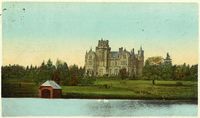Annotation:Bank (1) (The): Difference between revisions
No edit summary |
No edit summary |
||
| Line 2: | Line 2: | ||
---- | ---- | ||
<p><font face="garamond, serif" size="4"> | <p><font face="garamond, serif" size="4"> | ||
'''BANK, THE.''' Scottish, Air (2/4 time). A Minor. Standard tuning (fiddle). AABB. "Communicated by Orchill Graham, Esq." (Gow). The lairds of Orchill were the Graham family. | '''BANK, THE.''' Scottish, Air (2/4 time). A Minor. Standard tuning (fiddle). AABB. "Communicated by Orchill Graham, Esq." (Gow). The lairds of Orchill were the Graham family. The original house in Orchill, Perthshire, was built in the early 18th century and is a traditional harled laird’s house with a Gothic tower and great hall. [[File:orchillhouse.jpg|200px|thumb|right|Orchill House]] | ||
<br> | |||
<br> | |||
Gow's coummuicant was William Graham of Orchill, also a fiddler, of whom it was said would visit Gow in nearby Dunkeld and stay up whole nights with him playing reels. On one occasion Niel exclaimed: “Troth, Orchill, you play weel;--be thankfu’, if the French should overturn our country, you and I can win our bread, which is mair than mony o’ the great folk can say.” | |||
<br> | <br> | ||
<br> | <br> | ||
Revision as of 17:27, 22 April 2014
Back to Bank (1) (The)
BANK, THE. Scottish, Air (2/4 time). A Minor. Standard tuning (fiddle). AABB. "Communicated by Orchill Graham, Esq." (Gow). The lairds of Orchill were the Graham family. The original house in Orchill, Perthshire, was built in the early 18th century and is a traditional harled laird’s house with a Gothic tower and great hall.

Gow's coummuicant was William Graham of Orchill, also a fiddler, of whom it was said would visit Gow in nearby Dunkeld and stay up whole nights with him playing reels. On one occasion Niel exclaimed: “Troth, Orchill, you play weel;--be thankfu’, if the French should overturn our country, you and I can win our bread, which is mair than mony o’ the great folk can say.”
Source for notated version:
Printed sources: Gow (Sixth Collection of Strathspey Reels), 1822; p. 34.
Recorded sources:
